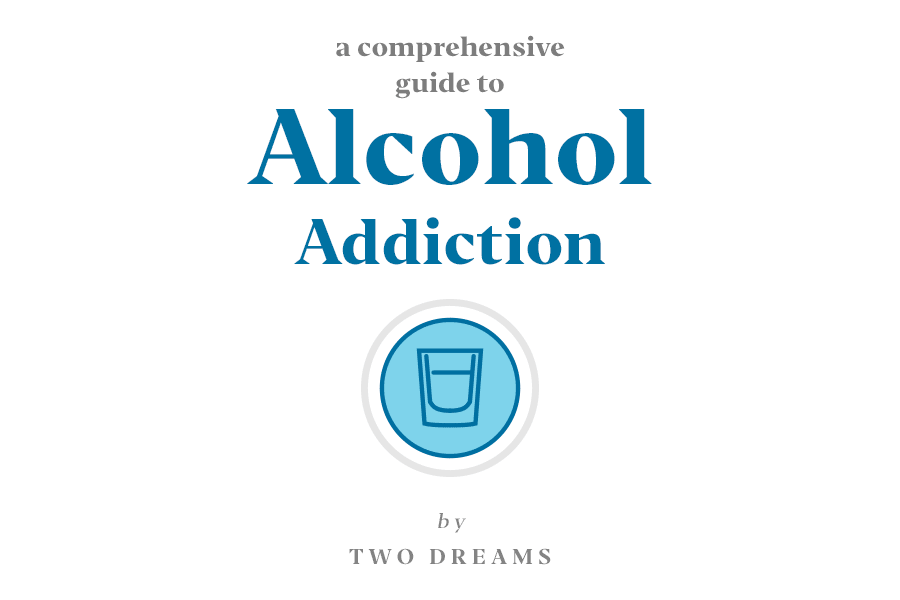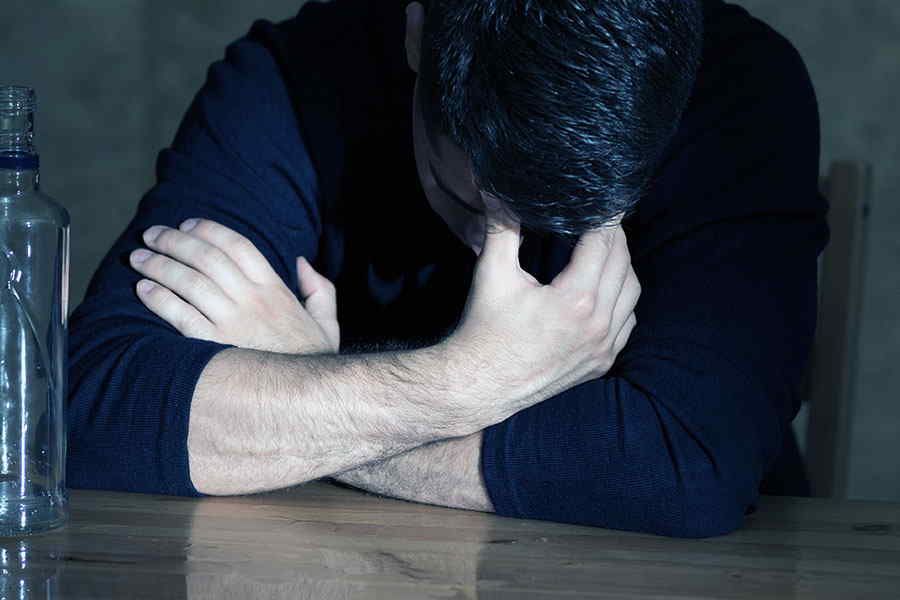
Need help with alcohol addiction for yourself or a loved one?
We provide the most advanced treatment in the industry. Contact us to learn more.
Signs, Symptoms, and Effects of Alcohol Addiction
What does alcohol do to the body?
Alcohol is a type of drug known as a Central Nervous System (CNS) depressant, meaning that it tends to decrease neuronal activity occurring in the brain and spinal cord.
This decrease in activity contributes to some of the slow, sedating side effects the drug imparts on its consumers, like slurred speech and stumbling movements.
Alcohol is able to cause this decrease in neuron activity by increasing the activity of an important cell-signaling chemical in the nervous system called y-aminobutyric acid, otherwise known as “GABA.” This neurotransmitter is the body’s main inhibitory signaler. It moves around interacting with neurons and instructing them to “calm down” or decrease activity. The GABA system specifically works to relieve anxiety, act as a sedative-hypnotic, inhibit memory storage, and more. Alcohol simultaneously enhances the depressing effects of GABA by decreasing the activity of “glutamate,” the body’s most ubiquitous excitatory neurotransmitter. The more alcohol one drinks, the more insistent GABA becomes in telling the nervous system to calm down.
Drinking a small amount can relieve anxiety and wear down inhibitions. Drinking past that point can cause sedation, then unconsciousness, then general anesthesia, and eventually death if the neurons critical to survival in the brainstem become inhibited.
What causes alcohol addiction?
Alcohol is a type of drug known as a Central Nervous System (CNS) depressant, meaning that it tends to decrease neuronal activity occurring in the brain and spinal cord.
This decrease in activity contributes to some of the slow, sedating side effects the drug imparts on its consumers, like slurred speech and stumbling movements.

Alcohol is able to cause this decrease in neuron activity by increasing the activity of an important cell-signaling chemical in the nervous system called y-aminobutyric acid, otherwise known as “GABA.” This neurotransmitter is the body’s main inhibitory signaler. It moves around interacting with neurons and instructing them to “calm down” or decrease activity. The GABA system specifically works to relieve anxiety, act as a sedative-hypnotic, inhibit memory storage, and more.
Alcohol simultaneously enhances the depressing effects of GABA by decreasing the activity of “glutamate,” the body’s most ubiquitous excitatory neurotransmitter. The more alcohol one drinks, the more insistent GABA becomes in telling the nervous system to calm down. Drinking a small amount can relieve anxiety and wear down inhibitions. Drinking past that point can cause sedation, then unconsciousness, then general anesthesia, and eventually death if the neurons critical to survival in the brainstem become inhibited.
A serving of alcohol is any drink that contains 0.6 fl oz of pure alcohol. The following portions count as a single serving size:
Alcohol Serving Sizes
- 12 fl oz of beer (an average can size)
- 8-9 fl oz of malt liquor
- 5 fl oz of wine
- 3-4 fl oz of fortified wine (ex. sherry, port)
- 2-3 fl oz of cordial, liqueur, or aperitif
- 1.5 fl oz of brandy or cognac
- 1.5 fl oz of an 80 proof distilled spirit (ex. a shot of liquor)
What are the signs and symptoms of alcohol abuse and addiction?
According to the Diagnostic and Statistical Manual of Mental Disorders (DSM-5), individuals must meet at least 2 out of 11 criteria during a 12-month period to receive a diagnosis of alcohol use disorder. The severity of the disorder is based on the number of criteria met (2-3 for mild, 4-5 for moderate, 6+ for severe.) The criteria are as follows:
Use Disorder Signs and Symptoms

- Had times when you ended up drinking more, or longer, than you intended?
- More than once wanted to cut down or stop drinking, or tried to, but couldn’t?
- Spent a lot of time drinking? Or being sick or getting over other aftereffects?
- Wanted a drink so badly you couldn’t think of anything else?
- Found that drinking—or being sick from drinking—often interfered with taking care of your home or family? Or caused job troubles? Or school problems?
- Continued to drink even though it was causing trouble with your family or friends?
- Given up or cut back on activities that were important or interesting to you, or gave you pleasure, in order to drink?
- More than once gotten into situations while, or after, drinking that increased your chances of getting hurt (such as driving, swimming, using machinery, walking in a dangerous area, or having unsafe sex)?
- Continued to drink even though it was making you feel depressed or anxious or adding to another health problem? Or after having had a memory blackout?
- Had to drink much more than you once did to get the effect you want? Or found that your usual number of drinks had much less effect than before?
- Found that when the effects of alcohol were wearing off, you had withdrawal symptoms, such as trouble sleeping, shakiness, restlessness, nausea, sweating, a racing heart, or a seizure? Or sensed things that were not there?
What are the effects of alcohol abuse and addiction?
Potential effects may include
- Injury
- Unintended pregnancy
- Alcohol poisoning
- Sexually transmitted diseases
- High blood pressure
- Stroke
- Cardiovascular disease
- Liver disease
- Neurological damage
- Diabetes
Can anyone become addicted to alcohol?
Yes, alcohol is a highly addictive substance that has the ability to affect everyone.
Addiction is not caused by a single factor, but rather a multitude of factors. It is considered to be hereditary, in the sense that people who have a first-degree relative with an addiction are more likely to develop an addiction than those who don’t. However, many addicts have no family history of addiction, so the role of genetics alone is inconclusive. Environmental factors play a significant role, and those exposed to family and friends using alcohol on a regular basis are more likely to try it than those individuals who would have to go out of their way to gain access to it. Peer pressure, low socioeconomic status, and lack of parental guidance are also contributing factors to alcohol addiction.
Alcohol Withdrawal
What are the causes of alcohol withdrawal?
Withdrawal refers to both the physical and emotional consequences of either suddenly ceasing to take or drastically reducing intake of the drug after dependence on the substance is established. The brain and body become accustomed to functioning under certain conditions with alcohol, so forcing them to quickly adapt to new ones can cause a wide array of issues.

Signs of alcohol withdrawal
Physical and mental signs of alcohol withdrawal
- Clammy skin
- Dilated pupils
- Insomnia
- Headache
- Nausea and vomiting
- Loss of appetite
- Rapid heart rate
- Pallor
- Sweating
- Tremors
- Anxiety
- Depression
- Irritability
- Fatigue
- Jumpiness
- Nightmares
- Mood swings
- Incoherent thinking
- Chest pain
- Fever
- Stomach pain
Severe alcohol withdrawal is called delirium tremens and involves

- Body tremors
- Delirium
- Fever
- Agitation, irritability
- Excitement, restlessness
- Hallucinations
- Extreme confusion, disorientation
- Fear
- Changes in mental function
- Decreased attention span
- Deep sleep that lasts for at least a day
- Increased activity
- Mood swings
- Hypersensitivity to surroundings
- Seizures (most common within the first 12-48 hours)
What happens during alcohol withdrawal?
The effects of alcohol withdrawal vary from person to person. Withdrawal symptoms typically occur within eight hours of the last drink, but may appear days later in some individuals. Symptoms usually peak within 24 – 72 hours of starting and may continue on for weeks.
Delirium tremens is a medical emergency that is most common in heavy users with a history of alcohol withdrawal. Symptoms usually set in within 48 – 96 hours of drinking, though they can occur up to 10 days after the last drink. We recommend that heavy alcohol users seek professional help and/or detoxification services before attempting to quit to avoid delirium tremens.
How does Two Dreams handle alcohol detox?
We do not personally offer detoxification services, however our professional staff is more than happy to refer patients to nearby clinics for detox before admission into our program.
Alcohol Overdose
Alcohol Overdose: The Risks and Effects
Ingesting a large amount of alcohol, either intentionally or not, can lead to serious consequences. This guide is for information purposes only and should not be used in case of an emergency.
If you suspect you or someone else has overdosed, call your local emergency hotline (ex. 911) or a poison control center (1-800-222-1222) immediately.
Signs of alcohol overdose
- Confusion
- Stupor
- Loss of consciousness
- Vomiting
- Slow or irregular breathing
- Hypothermia, blue skin, paleness
- Seizures
What to do if someone is overdosing on Alcohol

If you suspect you or someone else has overdosed, call your local emergency hotline (ex. 911) or a poison control center (1-800-222-1222) immediately, as overdose can lead to widespread organ injury and/or death if not handled quickly. It is helpful to know the strength of the ingested drug, as well as the time it was taken, the amount taken, and whether or not it was prescribed. The operator will also likely ask for the person’s age, weight, and current condition.
Alcohol Addiction: What To Do Next
What are my next steps?
Please call us here at Two Dreams if you find yourself struggling with alcohol use; our lines are open 24 hours a day, seven days a week.
Two Dreams offers a safe, judgment-free place to start the healing process. There are many different ways to start managing addiction, and we understand that what works for one person may not necessarily work for another. We provide inpatient, intensive outpatient, and outpatient services based on the unique needs of each individual and the level of care needed. Our trained counselors, under the supervision of a physician, are happy to talk through these options with you and help decide which placement will best fit your needs.
We ensure that the transitions into and out of treatment are as stress-free as possible by guiding you through each process step-by-step. Additionally, we provide step-down transition programs to help you shift out of the treatment center setting.
Our expert staff has been helping people with addiction for decades, so you can be sure that you and your loved ones will be in good hands. Dr. Andrea Barthwell, founder and CEO of Two Dreams, is widely regarded as one of the “Best Doctors in America” in the field of addiction medicine. She served as president of the American Addiction Society of Medicine (ASAM), as well as Deputy Director for Demand Reduction in the White House under President George W. Bush. Her renowned status and experience in the field have allowed her to shape Two Dreams into the outstanding recovery center that it is today—one that is able to provide state-of-the-art care and services to those in need.
We are here to help you in any way that we can; we are on your side.
Education Resources/Sources Cited
- Adult Children of Alcoholics World Service Organization, Inc.
- Al-Anon/Alateen Family Group
- Alcoholics Anonymous (AA)
- American Society of Addiction Medicine (ASAM)
- Centers for Disease Control (CDC)
- Faces & Voices of Recovery
- National Institute on Alcohol Abuse and Alcoholism (NIAAA)
- National Institute on Drug Abuse (NIDA)
- Office of National Drug Control Policy (ONDCP)
- Substance Abuse & Mental Health Services Administration (SAMHSA)
- U.S. National Library of Medicine (NLM)
How We Treat Alcohol Addiction at Two Dreams
What makes our alcohol addiction treatment plans effective?
Our unique 3-7-3 model allows for each patient to explore their own recovery while simultaneously healing alongside their peers.
Our Unique Treatment Model
Three Phases
The first “3” refers to our three phases of treatment: coming in, looking in, and looking out. In brief, the Coming In phase is about making the decision to come into the treatment center and learning to trust and tell your story. The Looking In phase is devoted to introspection, acknowledging the addiction, committing to recovery, and reducing or eliminating inducements to use. The Looking Out phase revolves around planning for life outside the treatment center, in terms of managing cravings, relationships, living arrangements, etc.
Seven Dimensions
The “7” refers to the seven dimensions of treatment we feel comprise a holistic treatment experience. In focusing on these aspects of life, we believe we can help our patients to become fully well rounded, self-sufficient individuals.
- Abstinence
- Peer Support
- Professional Guidance
- Medication Review
- Nutrition
- Exercise
- Ritual (12-Step Component)
Three Outcomes
The last “3” refers to the three outcomes we aspire to achieve in treatment: mental peace, physical well-being, and personal productivity. In achieving mental peace, patients can cast off the negative emotions fostered by addiction and replace them with feelings of self-worth, positivity, and hope for the future. In achieving physical well-being, patients embrace the mind-body connection and live the healthy lifestyle necessary for fostering a healthy mindset. In achieving personal productivity, patients play to their strengths and contribute to society in their own way while continuing their recovery journey.
Learn more about our unique program, or watch a short introduction video from our founder, Dr. Andrea Barthwell.
What will you experience during treatment for alcohol addiction at Two Dreams?
Two Dreams provides every client with a copy of The Big Book of Alcoholics Anonymous, otherwise known as the “Big Book,” upon arrival at the treatment facility. This foundational text contains descriptions of the 12 steps, as well as lessons we can learn from them and from addiction in general. It also contains a handful of testimonials by individuals who have followed the program as a method of recovery support.
The values of the 12-step program are omnipresent throughout our treatment plans. We encourage thorough self-evaluation during group and individual therapy sessions. We discuss the role of selfishness as it relates to addiction. We ask that clients take time during the day to journal and reflect on the self and their progress. We contemplate the idea of God and spirituality. We urge clients to assist others on their recovery journeys by sharing personal experiences and advice. We assign “step work” workbooks that are designed to thoroughly explain the implications of the first three steps. We encourage family members to participate in their own recovery by attending support groups of their own such as Alanon. We even transport clients to weekly AA/NA groups (or alternative, well-established support groups) held by members of the local community.
That being said, the 12-step model is only one part of the comprehensive support that we provide at Two Dreams. Our unique program combines the 12-step modality with behavioral therapies, motivational enhancement therapy, psychiatric care, and other psychosocial methods. We fully embrace the 12-steps as an important part of recovery support, but also realize that it can be most beneficial when used in conjunction with other modalities.
The treatment experience at Two Dreams also involves daily process group therapy sessions, individual counseling sessions, physical activities, nutritional guidance, journaling and mindfulness exercises, recreational experiences, and more. We believe that addiction is best addressed holistically and we take pride in our ability to instill in you the tools needed to achieve mental peace, physical wellbeing, and personal productivity.

Daily Ritual at Two Dreams
Ritual is a key component of beating addiction; by ritualizing your daily schedule, you can largely remove the irrational, emotional risk-taking behaviors that oftentimes lead to relapse. We help patients to develop their own rituals by turning them on to some of our own evidence-based habits for success. For example, every morning patients wake up and take a walk on the beach, bathing their eyes in sunlight to encourage the switch from GABA to glutamate, AKA sleep to wake. They then enjoy a 4 oz. fruit and vegetable smoothie after that to start their metabolism and further encourage wakefulness.
The Two Dreams Advantage
We have a maximum of 10 patients at any given time, so we are able to continually update and evaluate each patient’s progress in an effort to maximize their outcomes. We aim for overall wellness, as opposed to just detoxification and abstinence, so when patients leave our beautiful beachside location they are ready to take on the challenges of everyday life.